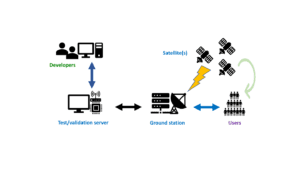

This means that previous probes that visited Mars only studied one side of Deimos' surface - until Hope. Deimos is tidally locked with Mars, meaning that the same side of Deimos is always facing the same side of Mars. The Martian probe to Deimos is historic for one additional reason. In other words, this theory holds that before Deimos was Deimos – as opposed to Deimos being an asteroid - that Deimos was originally part of Mars. Of course, as The New York Times reported, it is not yet clear with any certainty how Deimos was formed from Mars. This isn't an unprecedented theory, as a similarly catastrophic strike from a much larger celestial body was what created the Earth-moon system over 4 billion years ago. If indeed Deimos is composed of the same minerals found on Mars, this opens the door to a new hypothesis: That Deimos, and possibly its sister moon Phobos, were formed after a large celestial object collided with Mars, sloughing off some of Mars' surface material in the process. Hence, through spectrometry, it became readily apparent to scientists Deimos was probably not a captured asteroid but a chunk of Mars that broke off from the planet at some point in its history. Al Matroushi first reported these findings on April 24th to the European Geosciences Union meeting in Vienna. "If there were carbon or organics, we would see spikes in specific wavelengths," Hessa Al Matroushi, the lead scientist at the Emirates Mars Mission (EMM), told Nature. The scientists involved in the study said that Deimos' composition did not resemble the carbon-rich nature of the asteroids that dominate the Asteroid Belt. How living on Mars would warp the human body 175 such Martian meteorites have been discovered on Earth, including one that may have held evidence of past life on Mars. The geologic history of every body in the solar system is unique - so much so that scientists have been able to figure out with little doubt that some small meteorites that struck Earth millions or billions of years ago originated on Mars. These types of spectrographic analyses are a common means of figuring out the composition, and therefore origin, of different bodies int he solar system. That suggests an entirely different origin than theorized. The Hope onboard instruments all showed a flat spectrum in their readings, meaning that Deimos is composed of the same minerals seen on Mars - as opposed to the carbon-rich rocks detected in asteroids. Using spectrometry, the scientists could analyze the readings and learn about the type of elements on the planet's surface.
#OMNIWEB SPACECRAFT DATA PSP#
Please check the PSP inventory plot and annual inventory plots for details.Deimos was probably not a captured asteroid but a chunk of Mars that broke off from the planet at some point in its history.ĭuring a fly-by mission of Deimos on March 10, the Hope mission team scanned the planet's surface using instruments that detected light waves ranging from the infrared to the extreme ultraviolet, according to Nature. The SPAN electron and ion data from SWEAP have been updated to version 04. NOTICE: February 2022: The PSP data have been extended up to November 2022, covering the rest of Orbit 13 and a part of the inbound leg of Orbit 14.

In addition, the system is now making the newly release version of CDF files ( V3.9.0). NOTICE: March 2023: The default plotting width has been changed to three times the standard width (see the "CHANGE the X-axis width" option to modify the setting).
#OMNIWEB SPACECRAFT DATA ARCHIVE#
NOTICE: March 2023: Wind MFI datasets WI_H3-RTN_MFI and WI_H4-RTN_MFI (RTN coordinates equivalents of WI_H0_MFI and WI_H2_MFI datasets) have been added to the SPDF archive and the system.
#OMNIWEB SPACECRAFT DATA PLUS#
REMINDER: CDAWeb offers CREATION of subset/supersets of data sets (by date and variables), CREATION of uniformly time binned data, PLOTS in PDF, PS and PNG formatted files, MOVIES of specific image sequences, ON-THE-FLY Inventory plots, ADJUSTABLE height time/spectrogram plots, plus many more options. To search for additional heliophysics data products, check the heliophysics data portal. To find all of the public data and documents archived by the SPDF, see the SPDF archive. Many datasets from current missions are updated regularly (even daily), including reprocessing older time periods, and SPDF only preserves the latest version. CDAWeb contains selected public non-solar heliophysics data from current and past heliophysics missions and projects.


 0 kommentar(er)
0 kommentar(er)
